Air Pollution Effects
By Irina Bright.
This article is part of our Environment section
See the complete list of all our Pollution Articles here.
Air pollution effects are many, and they may be really harmful. We discuss them in more detail in the article below.
Contents
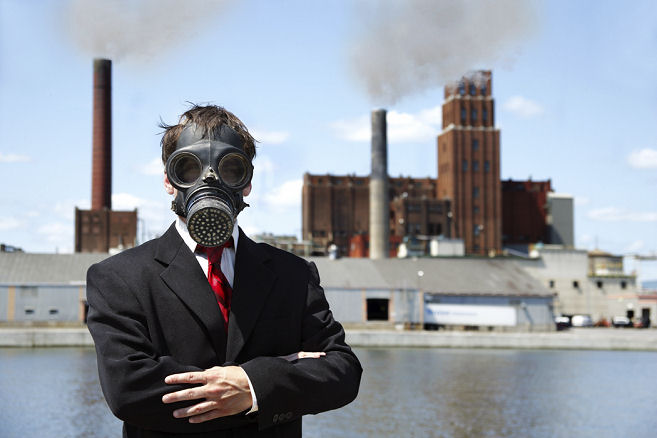 Air Pollution Affects Your Health
Air Pollution Affects Your Health
Introduction
Effects on Humans
Sulfur Dioxide EffectsNitrogen Dioxide Effects
Carbon Monoxide Effects
Ozone Effects
Ammonia Effects
Volatile Organic Compounds
Airborne Particles
Effects on Animals
Effects on Trees
Effects on Environment
Economic Losses
References
___Introduction
We can distinguish between short-term acute effects and long-term chronic effects of air pollution. Acute effects may be brought on, for instance, by pollution episodes, while chronic effects may generally affect a greater proportion of the population. (Ref. 1)
It is important to remember that air pollutants are transboundary, i.e. they know no borders and travel easily from their sources towards other locations spreading pollution throughout the world.
The respiratory system is by far the most important route for entry of air pollutants into the body (ref. 2) and thus becomes their primary target.
Air pollution affects virtually everyone but is considered to affect poorer people more than wealthier ones. (Ref. 3)
Air Pollution Effects on Humans
Air Pollution Effects: Sulfur Dioxide
Sulfur dioxide (SO2) is a colorless gas with a pungent, suffocating odor. SO2 is corrosive to organic materials and it irritates the eyes, nose and lungs; therefore it is quite a dangerous air pollutant. (Ref. 4)
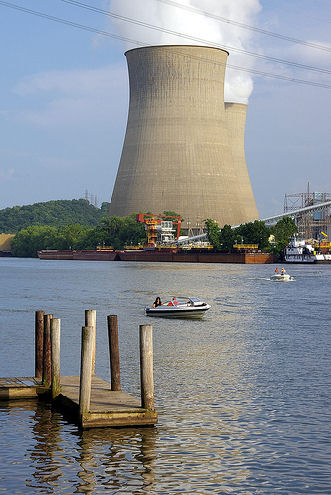 Coal Power Plant, USA
Coal Power Plant, USA © Wigwam Jones
Sulfur is contained within all fossil fuels, and is released in the form of sulfur dioxide during fossil fuel combustion.
Because of the widespread use of fossil fuels, sulfur dioxide is among the most common air pollutants produced in every part of the planet.
Sulfur dioxide may often act in synergy with other pollutants (ex., airborne particles) to produce certain air pollution effects.
Let’s summarize some sulfur dioxide pollution effects on human health: (Ref. 5, 6, 7)
- Irritation of eyes, nose, throat; damage to lungs when inhaled
- Acute and chronic asthma
- Bronchitis and emphysema (as a result of synergy between SO2 and suspended particulate matter)
- Lung cancer
Sulfur dioxide also affects animals, plants and the environment which we discuss below.
The Great Smog of London And Air Pollution Effects in Other Examples
One of the best known sulfur-related pollution episodes took place in London between December 5-9, 1952 when high concentrations of air pollution were trapped to the ground due to specific weather conditions at the time.
Because of the cold winter, Londoners were burning more low-quality, high-sulfur coal to heat their homes. Experts conclude that it may have been a combination of sulfur oxides with particulates and other air pollutants that produced such heavy pollution. (Ref. 8)
The results were 4,000 deaths which occurred during this period and another 8,000 in the months that followed. Many deaths were due to respiratory tract infections from hypoxia (low levels of oxygen in the blood) and due to the obstruction of air passages by pus arising from lung infections. (Ref. 9)
In a more recent 1992 sulfur-pollution episode in the Mae Moh region of Thailand, where power plants were burning high-sulfur coal without emission controls, around 4,000 residents required medical treatment after weather conditions trapped sulfur dioxide pollution over the area. This episode also caused the death of cattle (with their hides blistered), and withering of crops. (Ref. 10)
In Poland, it was found that new army recruits living in areas polluted by sulfur dioxide had 4 times more asthma and 3 times more bronchitis than people from cleaner areas. Also, men living in the most polluted areas of Krakow were reported to have losses of lung function equivalent to the effects of smoking. (Ref. 11)
Air Pollution Effects: Nitrogen Dioxide
 Ho Chi Minh Traffic
Ho Chi Minh Traffic© Graham Bertie
Nitrogen dioxide (NO2) is a gas of reddish-brown color with a distinct sharp, biting odor. It is often analyzed in conjunction with another nitrogen gas – nitric oxide (NO). Together these two gases are referred to as NOx.
Combustion of fossil fuels always produces both NO2 and NO.
But almost 90% of the NOX combustion product is in the form of NO which is then oxidized to NO2 in the air. (Ref. 12, 13)
NOx can destroy organic matter, ex. human tissue. Exposure to high concentrations of NOx can make living organisms more susceptible to bacterial infections and lung cancer. (Ref. 14)
Just like other pollutants, nitrogen dioxide carries negative air pollution effects on people with existing medical conditions - who are generally affected more severely than healthy people.
For example, asthma sufferers may experience enhanced sensitivity after short-term NO2 exposure as compared to those without any asthmatic problems. (Ref. 15)
Another group at higher risk is children. For instance, children aged 12 and younger who are exposed to NOx suffer more respiratory illness than the ones who are not exposed. (Ref. 16)
Depending on different NO2 concentrations in the air, nitrogen dioxide air pollution effects may be as follows: (Ref. 17, 18)
- Increased incidence of respiratory illness
- Increased airway resistance (due to inflammation)
- Damage to lung tissue
- Chronic obstructive pulmonary disease, or COPD (narrowing of the airways)
- Emphysema (as part of COPD)
- Pulmonary edema (accumulation of excessive fluid in the lungs)
- Infant and cardiovascular death
It is important to note that nitrogen dioxide is a major component of the photochemical smog and thus a contributor to the formation of ozone which is another serious air pollutant. See more about effects of ozone here.
Air Pollution Effects: Carbon Monoxide
 Kathmandu Pollution
Kathmandu Pollution © Lukasz Z
Carbon monoxide (CO) is an extremely toxic gas which affects the ability of the body to receive oxygen. Hemoglobin which transports oxygen in the blood is bound by carbon monoxide, which leads to the shortage of oxygen in the body. (Ref. 19)
Carbon monoxide is the most common type of fatal poisoning in many countries around the world. (Ref. 20)
Unlike many other air pollutants, carbon monoxide does not directly affect eyes, nasal passages or lungs. (Ref. 21)
Exposure to carbon monoxide may lead to the following air pollution effects (Ref. 22, 23, 24):
- Toxicity of the central nervous system and heart
- Headaches, dizziness, nausea and unconsciousness
- Loss of vision
- Decreased muscular coordination
- Abdominal pain
- Severe effects on the baby of a pregnant woman
- Impaired performance on simple psychological tests and arithmetic; loss of judgment of time
- In cases of prolonged exposure to high CO concentrations, unconsciousness, convulsions and death would occur
Carbon monoxide air pollution effects are exacerbated in weaker people, specifically in those with heart and lung diseases. (Ref. 25)
What makes this gas even more dangerous is the fact that it is invisible and odorless, and thus not immediately detectable as a hazard.
Air Pollution Effects: Ozone Effects
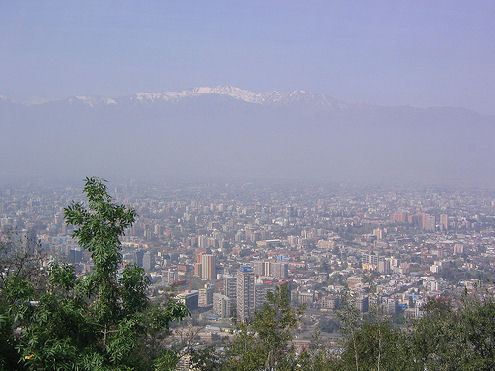 Santiago Smog
Santiago Smog© Phil Whitehouse
Ozone (O3) is a poisonous gas with a sharp and cold odor.
It can be found in the stratosphere where it occurs naturally and plays a beneficial role by protecting the Earth from ultraviolet sunlight; and in the troposphere where it occurs naturally and also forms part of the human-caused photochemical smog.
It is of course the tropospheric ozone that we are interested in as an important air pollutant.
The chemical reaction between nitrogen oxides and volatile organic compounds (VOCs) in the presence of sunlight results in the photochemical smog; the tropospheric ozone is an end product of this reaction and a component of the smog itself.
Because the photochemical smog requires a lot of sunshine to form, it occurs mostly in sunny and heavily polluted places, such as Los Angeles, Mexico City and even Athens.
Ozone’s main “victim” within the human body is its respiratory system.
Once in the lungs, ozone burns through cell walls. The immune system fails to protect the lungs because ozone pushes the defensive cells back. As cellular fluid starts seeping into the lungs, breathing becomes rapid, shallow and painful. (Ref. 26)
Exposure to ozone over long periods of time leads to a stiffening of the lungs and a reduced ability to breathe. (Ref. 27)
As an example, a study conducted in California in the 1980s shows that children living in ozone-polluted areas have smaller than normal lungs and adults lose up to 75% of their lung capacity. (Ref. 28)
So, exposure to the tropospheric ozone may cause the following air pollution effects: (Ref. 29, 30, 31)
- Burning nose and watering eyes
- Tightening of the chest
- Coughing, wheezing and throat irritation
- Rapid, shallow, painful breathing
- Susceptibility to respiratory infections
- Inflammation and damage to the lining of the lungs
- Aggravation of asthma
- Fatigue
- Cancer
Air Pollution Effects: Ammonia Effects
 Ammonia Fertilization
Ammonia FertilizationAustralia, c. 1975
© Rae Allen
Ammonia is a colorless, pungent, hazardous caustic gas composed of nitrogen and hydrogen.
Though ammonia is used for different applications in many sectors, agriculture is its largest consumer and producer. Livestock farming, animal waste and fertilizer application are the biggest sources of atmospheric ammonia emissions within the agricultural sector.
Gaseous ammonia is a dangerous air pollutant. Breathing in large amounts can cause death. (Ref. 32)
So, ammonia air pollution effects are: (Ref. 33, 34, 35)
On the respiratory system:
- Nose & throat irritation and burns (their severity increasing with the increased ammonia concentrations)
- Swelling of the throat and airways; airways destruction
- Pulmonary edema
- Chronic lung disease
- Cough
- Asthma
- Lung fibrosis
- Inhaling large amounts of ammonia can be fatal
On the skin & eyes:
- Skin burns
- Skin conditions, ex. dermatitis
- Burning sensation in the eyes
- Ulceration & perforation of the cornea (can occur months after exposure); blindness
- Cataracts & glaucoma
We know that ammonia is most hazardous when emitted or released in very high concentrations.
A recent example of the dangers posed by high ammonia concentrations is a train derailment which occurred in Minot, North Dakota, on January 18, 2002 and resulted in a massive gaseous ammonia leak of around 200,000 gallons. The leak formed a toxic cloud that drifted over the town for some time. As a result of this accident, one man died and many others were seriously injured. (Ref. 36)
Air Pollution Effects: Volatile Organic Compounds
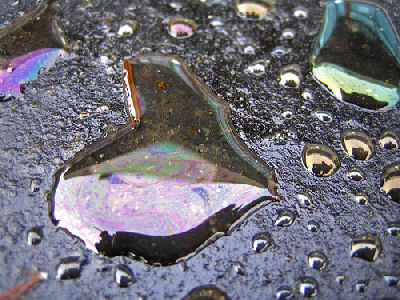 Oil is a source of VOCs
Oil is a source of VOCs© Jay-P
Volatile organic compounds (VOCs) are defined as organic compounds which easily evaporate and enter the atmosphere.
VOCs are important pollutants for two reasons.
First , they are precursors to the formation of ozone (which is part of the photochemical smog); second, they include compounds which are carcinogenic and mutagenic in their own right. (Ref. 37)
Typical VOCs include propane, benzene, ethanol, methanol, ether, carbon tetrachloride and vinyl chloride; substances such as petrol and resins contain many individual VOCs, and many others are produced during combustion processes. (Ref. 38)
Toxicity of some VOCs and ensuing health effects are no doubt issues of serious concern.
For example, exposure to benzene and 1,3-butadiene is a suspected cause of around 10% of leukemia incidence in the UK. (Ref. 39)
Exposure to toluene – another dangerous VOC – may lead to the dysfunction of the central nervous system resulting in behavioral problems, memory loss and disturbance of the circadian rhythm (ref. 40); toluene is also suspected to cause cancer (ref. 41).
Some other VOCs, ex. carbon tetrachloride and PCBs, are believed to produce abnormal changes in fetus development (ref. 42) and consequently lead to birth defects. Carbon tetrachloride also leads to liver damage (ref. 43).
Vinyl chloride causes Raynaud's phenomenon (spasms in the small arteries that cause the extremities to become pale and cold, as well as painful), necrosis of the small bones of the hand, liver damage, and a rare, highly malignant tumor of the liver. (Ref. 44)
Benzene air pollution effects on human health: (Ref. 45)
- Short-term breathing of low levels of benzene can cause drowsiness, dizziness, rapid heart rate, headaches, tremors, confusion and unconsciousness; exposure to high levels of benzene may result in death
- Chronic effects:
- Damage to the bone marrow
- Decrease in red blood cells (anemia)
- Excessive bleeding and depression of the immune system increasing the risk of infection
- Leukemia
1,3-Butadiene pollution effects on human health: (Ref. 46)
- Short-term exposure to high levels of 1,3-butadiene may lead to distorted blurred vision, vertigo, general tiredness, decreased blood pressure, headache, nausea, decreased pulse rate, and fainting
- Long-term exposure to high levels can increase the risk of cardiovascular diseases and cancer
Let us summarize some effects of VOCs on human health:
- Tiredness, vertigo, drowsiness, dizziness, nausea, confusion, unconsciousness
- Anemia
- Bone marrow damage
- Liver damage
- Dysfunction of the central nervous system:
- Behavioral problems
- Memory loss
- Disturbance of the circadian rhythm
- Cardiovascular diseases
- Cancer; specifically leukemia
- Abnormal changes in fetus development, birth defects
- VOCs also contribute to sick building syndrome indoors
- As facilitators in ozone formation, VOCs may indirectly contribute to respiratory problems
 Tiredness
TirednessAir Pollution Effects: Airborne Particles
Airborne particles are tiny fragments of solid or liquid nature suspended in the air (which are called aerosols).
Particles may be primary – when emitted into the atmosphere directly by sources, or secondary – when formed in the atmosphere through the interaction of primary pollutants.
For example, sulfur oxides and nitrogen oxides are primary pollutants which may transform in the air into sulfates and nitrates. (Ref. 47)
 Soot Pollution, England
Soot Pollution, England© Owen Benson
Dust particles are solid particles between 1 and 100 μm (micrometres) in diameter; fumes, or smoke, are solid particles less than 1 μm in diameter.
Experts believe that dust is the most damaging among all widely measured air pollutants. (Ref. 48)
Smaller dust particles are more dangerous than larger ones because they can penetrate deep into the lungs being deposited on areas where the body’s natural clearance mechanisms such as coughing cannot remove them. (Ref. 49)
Combustion of fossil fuels by road transport, power plants etc. is a major source of particulate air pollution.
Particles may come in a whole variety of chemical compositions including heavy metals such as cadmium, mercury and lead. (Ref. 50)
They often act in synergy with other air pollutants, ex. sulfur dioxide, to produce negative health effects in humans.
As the levels of particulate pollution rise, it commonly causes the following air pollution effects: (Ref. 51)
- Stuffy noses, sinusitis
- Sore throats
- Wet cough, dry cough, phlegm
- Head colds
- Burning eyes
- Wheezing; shortness of breath
- Lung disease
- Chest discomfort or pain
As with other pollutants, children are of course more susceptible to particulate pollution.
Specific children’s disorders caused by airborne particles may include: (Ref. 52, 53, 54)
- Infant death
- Low birth weight
- Reduced lung function
 Protection from Pollution
Protection from Pollution Los Angeles
© Dave Blume
Here is a summary of the particulate air pollution effects provided by the US Environmental Protection Agency: (Ref. 55)
- Increased respiratory symptoms (ex. irritation of the airways, coughing, difficulty breathing)
- Decreased lung function
- Aggravated asthma
- Chronic bronchitis
- Irregular heartbeat
- Nonfatal heart attacks
- Premature death in people with heart or lung disease
Indeed, particulate pollution affects both developed and developing countries:
- For example, a major study conducted in the US between 1982 and 1989 found that people living in American cities with the highest levels of particulate air pollution were 15% to 17% more likely to die one to three years early. (Ref. 56)
- In another example, particulate air pollution is linked to nearly 350,000 premature deaths in China and India every year. (Ref. 57)
Air Pollution Effects on Animals
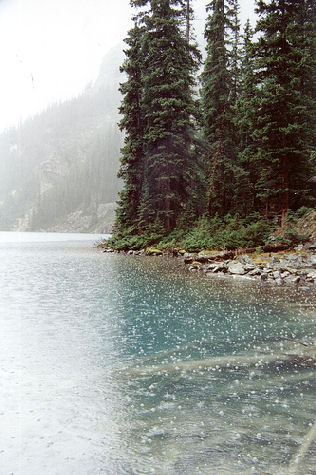 Hope this rain is not acidic
Hope this rain is not acidic© Heather Dietz
We don’t know a lot about air pollution effects on animals.
Probably one of the best examples here is that of acid rain and how it affects freshwater animal life.
Sulfur dioxide and nitrogen dioxide are transformed in the atmosphere to produce acid compounds – sulfuric and nitric acids. These compounds then fall back on to the ground as particulates or raindrops – in other words, acid rain.
So acid rain also falls on streams and lakes, acidifies them and destroys fish life in these freshwater ecosystems. (Ref. 58)
For example, in Sweden acid rain made over 18,000 lakes so acidic that all the fish died out. (Ref. 59) Salmon species appear to be particularly sensitive to acidity. (Ref. 60)
Some other populations of animals in Europe and North America that have also been declining due to acid rain are brown trout, mayfly larvae, beetle larvae, mollusks, and aquatic bird species (ex., the dipper). (Ref. 61)
Pollution may also affect animals through plants on which they feed.
For example, pea aphids feed on pea plants exposed to sulfur dioxide in the air. High exposure to sulfur dioxide negatively affects the health of the pea plants, and therefore, the health of the aphids as well. (Ref. 62)
Some other examples of air pollution effects on animals:
Excessive ultraviolet radiation coming from the sun through the ozone layer in the upper atmosphere which is eroded by some air pollutants, may cause skin cancer in wildlife (Ref. 63)
Tropospheric ozone may damage lung tissues of animals (Ref. 64)
It is also probably logical to assume that many higher order animals (especially those closely related to humans, ex. mountain gorillas) experience air pollution effects similar to those experienced by humans.
Air Pollution Effects on Forests, Trees & Plants
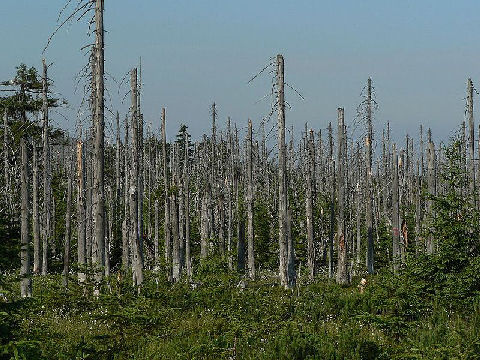 Trees Damaged by Sulfur Emissions, Czech Republic
Trees Damaged by Sulfur Emissions, Czech Republic Via Wikimedia.org
Air pollution can have both long-term and short-term effects on plants.
Physical injury to leaves is the immediate effect of air pollution on plants. Here is how leaves are affected by different air pollutants: (Ref. 65)
- Ozone produces a speckle of brown spots, which appear on the flat areas of leaf between the veins
- Sulfur dioxide: larger bleached-looking areas
- Nitrogen dioxide: irregular brown or white collapsed lesions on intercostal tissue and near the leaf edge
- Ammonia: unnatural green appearance with tissue drying out.
Of all main air pollutants, sulfur dioxide often comes up as the one that most negatively affects plants & trees.
Here is a very illustrative example of how destructive sulfur dioxide can be to vegetation.
The development of ore deposits in Canada in the middle of the 20th century was a major source of sulfur dioxide emissions in high concentrations. Sulfur emissions of one specific iron smelting plant in Wawa, Ontario, caused the destruction of large tracts of native boreal forest (spruce, cedar, larch and pine), in a belt stretching some 30 km from the smelter. (Ref. 66)
Another good example is that of the Black Triangle – the area where the borders of Germany, Poland and the Czech Republic meet, with significant brown coal deposits. Industrial activity in this area led to high sulfur emissions which resulted in devastation of many square kilometers of forest (incl. the Norway spruce forest), particularly above an altitude of 750 m. (Ref. 67)
However, it has been noted that sulfur dioxide concentrations in the atmosphere have recently been significantly reduced almost throughout the world (ref. 68) and do not carry such dramatic effects as they used to during the 20th century.
Lichens are considered to be most sensitive to sulfur dioxide. During the period of high levels of sulfur pollution, large parts of Europe lost many species of lichen and became known as “lichen deserts”. But as sulfur pollution levels dropped, many lichen species re-appeared. (Ref. 69)
Sulfur dioxide may also affect higher plants, including wild species, crops and trees (though some species may develop sulfur dioxide tolerant populations in response to long-term exposure).
These air pollution effects may be: (Ref. 70)
- Cell metabolism disruption (membrane damage, respiration and photosynthetic effects)
- Leaf injury and loss
- Reduced growth and reproduction
- Increase in susceptibility of plants to attacks by insect herbivores.
Nitrogen dioxide, another air pollutant, may act in synergy with sulfur dioxide to produce a negative effect on plants’ photosynthesis. (Ref. 71)
Tropospheric ozone can prevent plant respiration by blocking stomata and negatively affecting plants’ photosynthesis rates which will stunt plant growth; ozone can also decay plant cells directly by entering stomata. (Ref. 72)
 Trees in a Cement Factory, Brazil
Trees in a Cement Factory, Brazil © Darlan Cunha
Particles, just like ozone, often affect plants & trees via blocking of leaf stomata through which plants undertake the gas exchange necessary for photosynthesis and respiration. (Ref. 73)
Andrew Farmer notes that:
“In sufficient quantities, dusts [i.e. particles] may form a smothering layer on leaves, reducing light and hence lowering photosynthetic rates. Many dusts are inert and so only act by shading. However, some dusts are also chemically active. Thus cement dust will also dissolve leaf tissue, resulting in additional injury. Coal dust may also contain toxic compounds. Dusts may also affect ecosystems through their action on soil. Thus the alkaline chemistry of limestone dusts can raise the soil pH of acid and neutral habitats, resulting in the loss of plant and animal species.” (Ref. 74)
So, particulate air pollution effects on plants & trees may be as follows: (Ref. 75)
- Blocked stomata
- Increased leaf temperature
- Reduced photosynthesis
- Reduced fruit set, leaf growth, pollen growth
- Reduced tree growth
- Leaf necrosis and chlorosis, bark peeling
Acid rain (a product of air pollution) severely affects trees and plants as well. It can kill trees, destroy the leaves of plants, can infiltrate soil by making it unsuitable for purposes of nutrition and habitation. (Ref. 76) It is also associated with the reduction in forest and agricultural yields. (Ref. 77)
Air Pollution Effects on Wider Environment
The air pollution effects of acid rain have been known for a long time.
Though experts admit that the problem of acid rain is generally under control, it’s still worth reiterating the effects brought on by acid rain on the wider environment.
Acid rain has adverse effects on: (Ref. 78)
- Forests & other vegetation
- Freshwater lakes & streams destroying aquatic life
- Soil
- Buildings & materials
Air pollution also has a negative impact on visibility. (Ref. 79)
Economic Losses as Air Pollution Effects
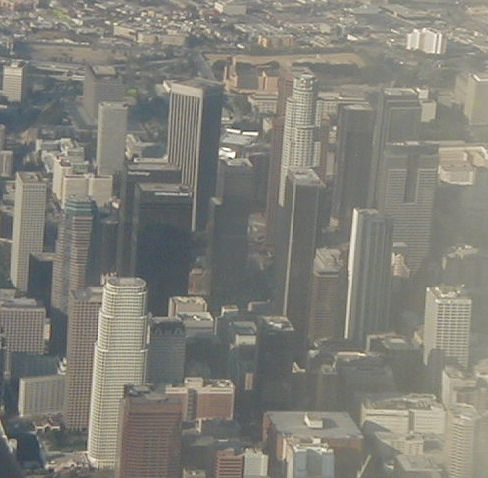 Downtown Los Angeles Smog
Downtown Los Angeles Smog© Jami Dwyer
Apart from direct health-related and other environmental issues, air pollution brings with it economic losses as well.
Some of the economic losses caused by air pollution are as follows: (Ref. 80)
- Direct medical losses
- Lost income from being absent from work
- Decreased productivity
- Travel time losses due to reduced visibility
- Losses from repair of damage to buildings
- Increased costs of cleaning
- Losses due to damage to crops & plants
For example, experts calculated that California is losing $28 billion every year in health care costs, school absences, missed work and lost income potential from premature deaths, because of air pollution in Southern California and in the San Joaquin Valley. (Ref. 81)
We can only imagine the economic losses incurred by developing countries such as China, where air pollution levels are among the highest in the world.
Written by: Irina Bright
Original publication date: 2008
Republication date: 2020
References
1. Farmer, A. (1997). Managing Environmental Pollution. London: Routledge, p. 34. Retrieved April 3, 2008 from Questia.com
2. Colls, J. (2002). Air Pollution. New York: Spon Press, p. 395. Retrieved April 3, 2008 from Questia.com
3. O'Neill, M. S., Jerrett, M., Kawachi, I., Levy, J. I., Cohen, A. J., Gouveia, N., et al. (2003). Health, Wealth, and Air Pollution: Advancing Theory and Methods. Environmental Health Perspectives, Vol. 111. Retrieved November 22, 2008 from Questia.com
4. Sulfur Dioxide. (2007). In The Columbia Encyclopedia (6th ed.). New York: Columbia University Press. Retrieved April 3, 2008 from Questia.com
5. Based on articles from:
Environmental Works. (2008). In Encyclopedia Britannica. Retrieved April 4, 2008 from http://library.eb.co.uk/eb/article-214274
6. Santos, M. A. (1990). Managing Planet Earth: Perspectives on Population, Ecology, and the Law. Westport, CT: Bergin & Garvey, p. 51. Retrieved April 3, 2008 from Questia.com
7. Ehrlich, P. R., Ehrlich, A. H., & Holdren, J. P. (1977). Ecoscience: Population, Resources, Environment. San Francisco: W. H. Freeman, pp. 546 – 7. Retrieved November 22, 2008 from Questia.com
8. Paulson, G. L., & Nadler, A. C. (1972). Air Pollution. In Ecology and Economics: Controlling Pollution in the 70s, Goldman, M. I. (Ed.) (pp. 73-101). Englewood Cliffs, NJ: Prentice-Hall, p. 81. Retrieved November 22, 2008 from Questia.com
9. Great Smog of 1952. (November 9, 2008). In Wikipedia, The Free Encyclopedia. Retrieved November 22, 2008 from http://en.wikipedia.org/w/index.php?title=Great_Smog_of_1952&oldid=250596376
10. Moore, C. A. (September/October, 1995). Poisons in the Air. International Wildlife, Vol. 25. Retrieved November 22, 2008 from Questia.com
11. Ibid.
12. Colls, J. (2002). Air Pollution. New York: Spon Press, p. 25. Retrieved April 3, 2008 from Questia.com
13. Farmer, A. (1997). Managing Environmental Pollution. London: Routledge, p. 26. Retrieved April 3, 2008 from Questia.com
14. Moore, C. A. (September/October, 1995). Poisons in the Air. International Wildlife, Vol. 25. Retrieved November 22, 2008 from Questia.com
15. Colls, J. (2002). Air Pollution. New York: Spon Press, p. 408. Retrieved April 3, 2008 from Questia.com
16. Moore, C. A. (September/October, 1995). Poisons in the Air. International Wildlife, Vol. 25. Retrieved November 22, 2008 from Questia.com
17. Colls, J. (2002). Air Pollution. New York: Spon Press, p. 408. Retrieved April 3, 2008 from Questia.com
18. Environmental Works. (2008). In Encyclopedia Britannica. Retrieved April 4, 2008 from http://library.eb.co.uk/eb/article-214274
19. Farmer, A. (1997). Managing Environmental Pollution. London: Routledge, p. 35. Retrieved April 3, 2008 from Questia.com
20. Carbon monoxide. (March 6, 2008). In Wikipedia, The Free Encyclopedia. Retrieved April 3, 2008 from http://en.wikipedia.org/w/index.php?title=Carbon_monoxide&oldid=196188223
21. Paulson, G. L., & Nadler, A. C. (1972). Air Pollution. In Ecology and Economics: Controlling Pollution in the 70s, Goldman, M. I. (Ed.) (pp. 73-101). Englewood Cliffs, NJ: Prentice-Hall, p. 84. Retrieved November 22, 2008 from Questia.com
22. Carbon monoxide. (March 6, 2008). In Wikipedia, The Free Encyclopedia. Retrieved April 3, 2008 from http://en.wikipedia.org/w/index.php?title=Carbon_monoxide&oldid=196188223
23. Ehrlich, P. R., Ehrlich, A. H., & Holdren, J. P. (1977). Ecoscience: Population, Resources, Environment. San Francisco: W. H. Freeman, p. 546. Retrieved November 22, 2008 from Questia.com
24. Paulson, G. L., & Nadler, A. C. (1972). Air Pollution. In Ecology and Economics: Controlling Pollution in the 70s, Goldman, M. I. (Ed.) (pp. 73-101). Englewood Cliffs, NJ: Prentice-Hall, p. 85. Retrieved November 22, 2008 from Questia.com
25. Ehrlich, P. R., Ehrlich, A. H., & Holdren, J. P. (1977). Ecoscience: Population, Resources, Environment. San Francisco: W. H. Freeman, p. 545. Retrieved November 22, 2008 from Questia.com
26. Moore, C. A. (September/October, 1995). Poisons in the Air. International Wildlife, Vol. 25. Retrieved November 22, 2008 from Questia.com
27. Ibid.
28. Ibid.
29. Ozone. (March 11, 2008). In Wikipedia, The Free Encyclopedia. Retrieved April 4, 2008 from http://en.wikipedia.org/w/index.php?title=Ozone&oldid=197484961
30. Tropospheric ozone. (March 5, 2008). In Wikipedia, The Free Encyclopedia. Retrieved April 4, 2008 from http://en.wikipedia.org/w/index.php?title=Tropospheric_ozone&oldid=196160653
31. Moore, C. A. (September/October, 1995). Poisons in the Air. International Wildlife, Vol. 25. Retrieved November 22, 2008 from Questia.com
32. Delaware Health & Social Services, State of Delaware (May, 2007). Public Information: Ammonia (NH3). Retrieved November 22, 2008 from http://www.dhss.delaware.gov/dph/files/ammoniapi.pdf
33. O’Fallon, D. & Sieff, P. (February 2002). Minot, North Dakota, Train Derailment. Published by Robins, Kaplan, Miller & Ciresi LLP. Retrieved November 22, 2008 from http://www.rkmc.com/Minot_North_Dakota_Train_Derailment.htm
34. Canadian Centre for Occupational Health and Safety (October 22, 2008). Ammonia Gas: Health Effects of Ammonia Gas. Retrieved November 22, 2008 from http://www.ccohs.ca/oshanswers/chemicals/chem_profiles/ammonia/health_ammonia.html
35. Delaware Health & Social Services, State of Delaware (May, 2007). Public Information: Ammonia (NH3). Retrieved November 22, 2008 from http://www.dhss.delaware.gov/dph/files/ammoniapi.pdf
36. O’Fallon, D. & Sieff, P. (February 2002). Minot, North Dakota, Train Derailment. Published by Robins, Kaplan, Miller & Ciresi LLP. Retrieved November 22, 2008 from http://www.rkmc.com/Minot_North_Dakota_Train_Derailment.htm
37. Colls, J. (2002). Air Pollution. New York: Spon Press, p. 409. Retrieved April 3, 2008 from Questia.com
38. Ibid.
39. Ibid.
40. Ibid., p. 410
41. Volatile organic compound. (November 12, 2008). In Wikipedia, The Free Encyclopedia. Retrieved November 22, 2008 from http://en.wikipedia.org/w/index.php?title=Volatile_organic_compound&oldid=251309593
42. Haughton, G., & Hunter, C. (2003). Sustainable Cities. London: Routledge, p. 153. Retrieved November 22, 2008 from Questia.com
43. Occupational Disease. (2008). In Encyclopedia Britannica. Retrieved November 17, 2008 from Encyclopedia Britannica Online Library Edition: http://library.eb.co.uk/eb/article-14278
44. Ibid.
45. Benzene. (November 16, 2008). In Wikipedia, The Free Encyclopedia. Retrieved November 22, 2008 from http://en.wikipedia.org/w/index.php?title=Benzene&oldid=252113046
46. 1,3-Butadiene. (November 3, 2008). In Wikipedia, The Free Encyclopedia. Retrieved November 22, 2008 from http://en.wikipedia.org/w/index.php?title=1,3-Butadiene&oldid=249411792
47. Moore, C. A. (September/October, 1995). Poisons in the Air. International Wildlife, Vol. 25. Retrieved November 22, 2008 from Questia.com
48. Bolt, K., Dasgupta, S., Pandey, K., & Wheeler, D. (2001). Minute Particles, Major Problems: New Policies Show Promise for Saving Millions of Lives by Clearing the Air in the Developing World. Forum for Applied Research and Public Policy, Vol. 16. Retrieved November 22, 2008 from Questia.com
49. Ibid.
50. Ehrlich, P. R., Ehrlich, A. H., & Holdren, J. P. (1977). Ecoscience: Population, Resources, Environment. San Francisco: W. H. Freeman, p. 543. Retrieved November 22, 2008 from Questia.com
51. Moore, C. A. (September/October, 1995). Poisons in the Air. International Wildlife, Vol. 25. Retrieved November 22, 2008 from Questia.com
52. Glinianaia, S. V., Rankin, J., Bell, R., Pless-Mulloli, T., & Howel, D. (2004). Does Particulate Air Pollution Contribute to Infant Death? A Systematic Review. Environmental Health Perspectives, Vol. 112. Retrieved November 22, 2008 from Questia.com
53. Bell, M. L., Ebisu, K., & Belanger, K. (2007). Ambient Air Pollution and Low Birth Weight in Connecticut and Massachusetts. Environmental Health Perspectives, Vol. 115. Retrieved November 22, 2008 from Questia.com
54. Phelps, J. (2004). Air Pollution Impairs Lung Development in Children. Environmental Health Perspectives, Vol. 112. Retrieved November 22, 2008 from Questia.com
55. U.S. Environmental Protection Agency (May 9, 2008). Particulate Matter: Health and Environment. Retrieved November 22, 2008 from http://www.epa.gov/oar/particlepollution/health.html
56. Moore, C. A. (September/October, 1995). Poisons in the Air. International Wildlife, Vol. 25. Retrieved November 22, 2008 from Questia.com
57. Associated Press (November 13, 2008). UN: Clouds of pollution threaten glaciers, health. Published by Yahoo! News. Retrieved November 22, 2008 from http://news.yahoo.com/s/ap/20081113/ap_on_sc/as_china_brown_clouds
58. Colls, J. (2002). Air Pollution. New York: Spon Press, p. 420. Retrieved April 3, 2008 from Questia.com
59. The Environment Agency (2008). Acid Rain. Retrieved November 22, 2008 from http://www.environment-agency.gov.uk/yourenv/eff/1190084/pollution/acid_rain/
60. Colls, J. (2002). Air Pollution. New York: Spon Press, p. 420. Retrieved April 3, 2008 from Questia.com
61. Ibid., p. 421
62. Ibid., p. 423
63. Gardiner, L. (February, 2006). Air Pollution Affects Plants, Animals, and Environments. Published by Windows to the Universe. Retrieved April 3, 2008 from http://www.windows.ucar.edu/tour/link=/earth/Atmosphere/wildlife_forests.html&edu=high
64. Ibid.
65. Colls, J. (2002). Air Pollution. New York: Spon Press, p. 354. Retrieved April 3, 2008 from Questia.com
66. Ibid., p. 344.
67. Ibid.
68. Farmer, A. (1997). Managing Environmental Pollution. London: Routledge, p. 49. Retrieved April 3, 2008 from Questia.com
69. Ibid.
70. Ibid., p. 51
71. Ibid., p. 47
72. Gardiner, L. (February, 2006). Air Pollution Affects Plants, Animals, and Environments. Published by Windows to the Universe. Retrieved April 3, 2008 from http://www.windows.ucar.edu/tour/link=/earth/Atmosphere/wildlife_forests.html&edu=high
73. Farmer, A. (1997). Managing Environmental Pollution. London: Routledge, p. 48. Retrieved April 3, 2008 from Questia.com
74. Ibid.
75. Ibid., p. 49
76. Gardiner, L. (February, 2006). Air Pollution Affects Plants, Animals, and Environments. Published by Windows to the Universe. Retrieved April 3, 2008 from http://www.windows.ucar.edu/tour/link=/earth/Atmosphere/wildlife_forests.html&edu=high
77. Santos, M. A. (1990). Managing Planet Earth: Perspectives on Population, Ecology, and the Law. Westport, CT: Bergin & Garvey, p. 51. Retrieved April 3, 2008 from Questia.com
78. Acid rain. (November 16, 2008). In Wikipedia, The Free Encyclopedia. Retrieved November 22, 2008 from http://en.wikipedia.org/w/index.php?title=Acid_rain&oldid=252152519
79. Farmer, A. (1997). Managing Environmental Pollution. London: Routledge, p. 53. Retrieved April 3, 2008 from Questia.com
80. Gilpin, A. (1999). Environmental Economics: A Critical Overview. Chichester, England: John Wiley & Sons, p. 201. Retrieved November 22, 2008 from Questia.com
81. Cone, T. (November 13, 2008). Study: Calif dirty air kills more than car crashes. Published by the Huffington Post. Retrieved November 22, 2008 from http://www.huffingtonpost.com/huff-wires/20081113/california-air-pollution/